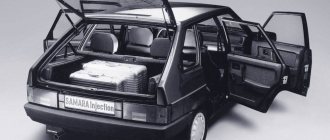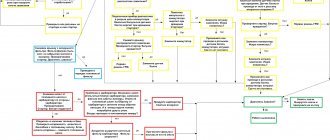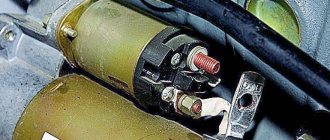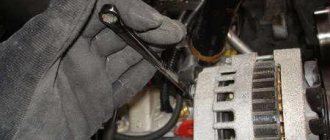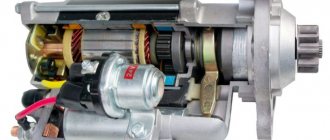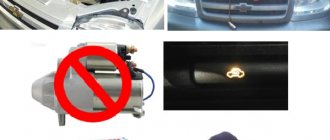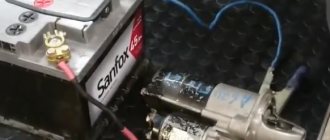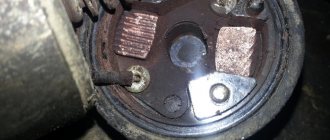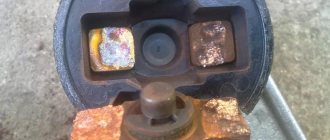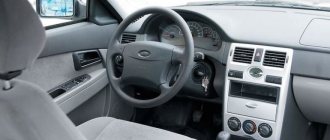VAZ 2109 won't start
What to do if your beloved VAZ 2108 2109 21099 refuses to start? This article will discuss a troubleshooting diagram. As you probably know, for the engine to start and run, three conditions are necessary: air, gasoline, spark. When the engine crankshaft rotates, a combustible mixture is sucked into the cylinders (a mixture of air and gasoline in a certain proportion). After closing the intake and exhaust valves at the end of the compression stroke, a spark should appear on the spark plug, igniting the combustible mixture - the engine starts. Let's consider the diagnostics of identifying a fault along the chain. The entire methodology is reflected in detail in the figure; the text provides the necessary comments on the points.
Troubleshooting algorithm
1) If the starter does not turn the crankshaft of the engine number nine, then check the following: the battery must be charged, when you turn the ignition key you should hear a click of the solenoid relay operating, all connectors must be connected to the starter.
2) If the starter rotates the crankshaft, then it is necessary to determine whether a flammable mixture or a spark is entering the cylinder. First we look for a spark. To do this, remove the high-voltage wire from any spark plug, bring it at a distance of a centimeter to the ground and turn the starter.
3) If there is no spark going to the spark plug, check whether the spark is going to the ignition distributor (distributor). To do this, remove the central wire from the distributor, bring it to ground at a distance of 1 cm and turn the starter. If a spark jumps from the wire to ground, the problem is in the ignition distributor: check the slider, clean the contacts.
Checking the spark from the ignition coil
4) If there is no spark to the ignition distributor, then diagnostics of the ignition system is necessary. There are two options for further troubleshooting: A) Using a non-contact ignition system diagnostic device. B) Manual fault detection. A) You have a device, their varieties may be different, but the principle of operation is the same: power supply and operation of the Hall sensor and switch are displayed by lights.
Diagnostic device for non-contact ignition system
The device is connected to the open circuit of the switch. Remove the connector from the switch and connect it to the device connector. Place the second connector of the device on the switch. Turn on the ignition: the ignition system power light and the Hall sensor power light should be on.
When the Zhiguli starter rotates, the following should blink: the switch control light, the pulse light from the Hall sensor. If the switch control light does not blink, replace the switch.
If there are no pulses from the Hall sensor, disassemble the ignition distributor and make sure that the distributor runner rotates when the starter rotates. If the starter turns, but the distributor runner does not, the timing belt is broken. If the slider rotates but there is no signal from the Hall sensor, replace the Hall sensor. B) Option for troubleshooting without an ignition diagnostic tool. Disassemble the ignition distributor and make sure that the distributor slider rotates when the starter rotates. If it doesn't turn, the timing belt is broken. If the slider rotates, check that the distributor drum does not touch the Hall sensor. Make sure the wires and connector of the Hall sensor are in good condition. If everything is normal, change the switch; the most common reason when there is no spark is the switch burned out. If, even after replacing the switch, a spark does not appear, suspicion falls on the ignition coil and connecting wires. The ignition coil (in popular parlance) fails extremely rarely, but such cases also happen.
5) If there is a spark, but the engine does not start, remove the air filter cover.
Air filter without cover
Is the filter clean and free of oil? We try to start it without the air filter cover, if it starts, it means there is no air access to the carburetor, the filter is clogged, the air supply is filled with oil. 6) If it doesn’t start, completely remove the filter with the cap and unscrew the fuel hose from the fuel pump to the carburetor on the carburetor side. We turn the starter - gasoline should spray out. Doesn't it splash? Either the fuel pump has failed, or fuel is not supplied from the tank, if there is any there, of course. 7) If gasoline splashes when the starter rotates, unscrew the fuel return hose from the carburetor. Plug the return with your finger and blow into the supply with your mouth. Is air passing into the float chamber? If yes, then gasoline is also passing through, you need to blow out the entire carburetor with compressed air. Is there air getting into the float chamber? Check the carburetor mesh filter. We unscrew it and clean it. Did not help? — The needle valve may be stuck. Tap the side of the carburetor with a wrench or blow compressed air into the feed hole. 9) If you still cannot blow air into the float chamber, remove the carburetor cover. We take it in our hands and try to blow it again. Air does not pass through - change the needle valve. 10) If air flows through when the cover is removed, but not when it is clamped on the carburetor, the fuel jets are clogged. The carburetor needs to be completely purged. 11) If after the work done the car still does not start, unscrew the spark plugs. Look, are they filled with gasoline or not? If they are flooded, you need to dry them. Turn on the gas stove and, holding the pliers, dry the candle over the fire. If the spark plugs are still dry, you can try spraying a few drops of gasoline into chamber 1 of the carburetor (closer to the passenger compartment). The resulting vacuum may pierce the carburetor and the engine will start.
We try to start it without the air filter cover, if it starts, it means there is no air access to the carburetor, the filter is clogged, the air supply is filled with oil. 6) If it doesn’t start, completely remove the filter with the cap and unscrew the fuel hose from the fuel pump to the carburetor on the carburetor side. We turn the starter - gasoline should spray out. Doesn't it splash? Either the fuel pump has failed, or fuel is not supplied from the tank, if there is any there, of course. 7) If gasoline splashes when the starter rotates, unscrew the fuel return hose from the carburetor. Plug the return with your finger and blow into the supply with your mouth. Is air passing into the float chamber? If yes, then gasoline is also passing through, you need to blow out the entire carburetor with compressed air. Is there air getting into the float chamber? Check the carburetor mesh filter. We unscrew it and clean it. Did not help? — The needle valve may be stuck. Tap the side of the carburetor with a wrench or blow compressed air into the feed hole. 9) If you still cannot blow air into the float chamber, remove the carburetor cover. We take it in our hands and try to blow it again. Air does not pass through - change the needle valve. 10) If air flows through when the cover is removed, but not when it is clamped on the carburetor, the fuel jets are clogged. The carburetor needs to be completely purged. 11) If after the work done the car still does not start, unscrew the spark plugs. Look, are they filled with gasoline or not? If they are flooded, you need to dry them. Turn on the gas stove and, holding the pliers, dry the candle over the fire. If the spark plugs are still dry, you can try spraying a few drops of gasoline into chamber 1 of the carburetor (closer to the passenger compartment). The resulting vacuum may pierce the carburetor and the engine will start.
The techniques described above will help you start a VAZ 2108 2109 21099 in more than 90% of cases. However, in case of problems that are difficult to diagnose (the timing belt has slipped by several teeth, poor or absent compression in the engine, the carburetor is not adjusted), only a service station can help you.
The starter turns, but does not start: diesel
The design of diesel cars differs from classic gasoline units. Here, ignition of the combustible mixture occurs according to a different principle, which imposes its own criteria for diagnosing the power plant.
Possible reasons
Among the most common problems are the following. Lack of glow The most common problem is burnout of the glow plug electrode. Checking spark plugs is carried out exclusively using special equipment. Failure of one element causes tripping or popping noises during engine operation. If the parts themselves are functioning properly, the reason may be hidden in the armored wires or power relay.
Note! Part failure can occur while the car is moving. Due to the sufficient temperature of the combustion chamber, problems begin only after the block has cooled.
Incorrect fuel supply A common problem in winter is diesel freezing or waxing of filter elements. In this case, it is necessary to change the cleaning grids and warm up the machine in a warm box. If it happens in the summer, the search for the “root of evil” is done like this.
- Incorrect operation of anti-theft equipment - the alarm is turned off or repaired.
- The condition of the main pump and the integrity of the fuel lines are checked. If a hose or tube leaks, air may be sucked through the crack, causing a problem.
- The injectors are unscrewed from the internal combustion engine block and tested on special stands. Often the pressure hole becomes clogged after pouring low-quality fuel or driving over potholes - sediment rises from the bottom of the gas tank and enters the engine.
- If the starter turns, but the engine doesn’t even start (there is also no smoke from the exhaust pipe), it means that diesel fuel is not entering the cylinders at all. The first step is to check the serviceability of the high pressure fuel pump (HPF) and its drive pump.
- Next, all lines for each injector are diagnosed individually.
- Calibrating the diesel feed angle. The injection pump belt may jump or break, which will cause incorrect fluid injection.
Common problems
Also, the reason that the starter turns but the engine does not start are common problems that are typical for all cars, regardless of the type of fuel consumed or its supply pattern. The main ones are: Jamming of attachments Jamming of the power steering drive, generator or coolant compressor. A stalled unit may prevent the crankshaft from turning. When starting the engine, you need to check whether all the pulleys rotate freely.
Reduced compression Loss of the required pressure inside the working cylinders can cause the combustible mixture to leak into the crankcase or exhaust manifold. There may be several sources here.
- Occurrence of piston rings. Tired seals can coke or even burst, which will certainly lead to a loss of nominal pressure.
- Worn or elliptical cylinders. This is an extreme case when a major overhaul of the internal combustion engine is required.
- Bent or defective valves. Inserts may break off or not fit tightly to the cylinder head.
- Timing belt rupture is a precursor to the above case.
- Formation of defects of thermal or mechanical origin. This includes cracks, chips or scratches in the block caused by overheating of the cylinder head. Also a violation of the design of the crankshaft and its fastenings (liners, connecting rods, pins).
- The worst reason is engine jamming (the engine knocked). In this case, a complete replacement of the unit is required, which entails costs comparable to 50% of the cost of the car.
- The most comical situation is that there is simply no fuel inside the tank. As a rule, this is caused by a malfunction of the float or the corresponding sensor. The problem is treated by visiting a gas station.
Carburetor engine does not start (reasons related to the ignition system)
Very often, the reason that a car engine does not start or starts and stalls is not a malfunction of the carburetor or power system, but problems with its ignition system.
If the engine does not start, in most cases it is recommended to first check the ignition system, and only then look for the problem in the carburetor. This is especially true when starting the engine in wet weather or when there is a temperature difference. Let's consider the most common reasons that a carburetor engine does not start due to a malfunction of the ignition system using the example of engine 2108 (21081, 21083) of VAZ 2108, 2109, 21099 cars and their modifications.
The easiest way to start troubleshooting is by visually inspecting the elements of the ignition system (suddenly something just jumped off somewhere) and then checking for the presence of a spark on the spark plugs (to determine whether the ignition system is working at all). And then move on to checking the armored wires, distributor cap, slider, etc.
The engine does not start or starts and stalls, reasons
— Battery is faulty
The battery could simply be dead. Its terminals or the tips of the power wires could also be oxidized. Oxidation can be removed with sandpaper, and the battery can be charged.
— Spark plugs are faulty
It is possible that the spark plug insulator is broken (current leakage to ground), or the gap between the spark plug electrodes is incorrect, or they are covered with black or oil deposits. To determine the malfunction, you need to unscrew the spark plugs and look at the carbon deposits on their electrodes. Check the gap. If the spark plug does not work at all, it may be flooded with fuel. See Spark Plug Problems. To determine the breakdown, you can perform a test by starting the engine in the dark (described in the Notes below).
Black carbon deposits on spark plugs
— High-voltage wires are connected in the wrong order
If for some reason the wires were disconnected from the spark plugs or the distributor cap, it is quite possible that they were installed back with an error. Check the order in which the wires are connected.
The procedure for connecting wires to the distributor cover on VAZ 2108, 2109, 21099
— Incorrectly set ignition timing
If the timing is too early or too late, it is quite possible that the engine will not start or will have difficulty starting and stall. We set the ignition timing using a strobe or by ear by rotating the distributor until a stable idle speed appears within 700-800 rpm. For the required advance angles and the order of their installation, see “Setting the ignition timing on carburetor engines of VAZ 2108, 2109, 21099”.
Adjusting the angle using a distributor
— High-voltage wires are faulty
High-voltage wires may have damage to the protective coating (“breakdown”). The easiest way to check it is by the presence of a glow on them by starting the engine in the dark. You can also check their resistance using a tester. In addition, during a visual inspection we identify oxidized or damaged wire tips.
Measuring the resistance of high-voltage wires
— Distributor cover is faulty
In the event of a “breakdown” of the distributor cover, it is necessary to remove it and inspect it. Traces of a “breakdown” are visible visually (dots, stripes). In addition, it is necessary to evaluate the condition of the contacts inside and outside the cover and the condition of the central contact “coal”.
— The ignition distributor (“slider”) is faulty
If the “runner” breaks down, it must also be removed and inspected. Traces of a “breakdown” are visible visually. An interference suppression resistor in the “runner” can also cause the engine to not start or to start and stall. Replace it with a piece of copper wire and restart the engine.
Ignition distributor (“slider”)
— Ignition coil is faulty
You can visually assess the condition of the ignition coil cover. Cracks in it are not allowed (especially around the central contact), as this is a sign of “breakdown”. You can check the coil more thoroughly using a tester. In case of its absence, temporary replacement with a known good one. See "Checking the Ignition Coil".
Checking the primary winding of the ignition coil
— Hall sensor is faulty
Determining the health of the Hall sensor without a voltmeter is very difficult (See “Checking the Hall sensor”). It is possible to replace it with a known good one and then restart the engine.
— The switch is faulty
Checking the serviceability of the switch without an oscilloscope is problematic. This can be done in advance using the voltmeter readings when turning the key in the ignition switch. See “Checking the switch of VAZ 2108, 2109, 21099 cars.”
Ignition system switch for VAZ 2108, 2109, 21099 cars
— Low voltage wires of the ignition system are faulty
Visually inspect the low voltage wires of the ignition system. We check for kinks, abrasions, chips that have come off or are not fully installed. We check the presence of voltage at terminal B+ of the coil and terminal 30/1 of the ignition switch. To help, you can take the “Ignition system diagram for VAZ 2108, 2109, 21099 cars.”
Diagram of the ignition system for VAZ 2108, 2109, 21099 cars
— The ignition switch is faulty
Current is supplied to the ignition system through terminals 30/1 (brown wire - current comes from the generator) and 15 (blue and black - current goes to the coil). If the contact in the block on the lock is oxidized or leaky, the ignition system will be de-energized and the engine will not start.
Notes and additions
— A preliminary check of the ignition system consists of checking the presence of a spark on the spark plugs (the unscrewed spark plug with the connected voltage wire is placed on the engine ground, the engine is cranked with the starter, the presence and strength of the spark on the spark plug is visually assessed). For more details, see “Checking the contactless ignition system of VAZ 2108, 2109, 21099 cars.”
— General check of the ignition system elements for breakdown: start the engine in the dark and visually inspect the spark plugs, armored wires, distributor cover, ignition coil. If they malfunction, sparking or glowing will be noticeable.
Repair and operation of the VAZ 2108 2109 21099 car
In the article “VAZ 2109 will not start,” we examined in detail the reasons why the VAZ 2108, VAZ 2109, VAZ 21099 carburetor does not start. However, injection VAZ 2109 have their own characteristics, so this article is intended to help the owners of a VAZ 2108 2109 21099 injector when their iron horse stops starting. The differences in troubleshooting for carburetor and injection engines are very significant. Thus, the owner of a carburetor VAZ 2108, VAZ 2109, VAZ 21099 can, with his eyes closed, determine why his car does not start. However, if you transfer him to an injection VAZ 2108, VAZ 2109, VAZ 21099, which does not start, then the person will not know what to do. It’s understandable: an electric fuel pump, an ECU, a bunch of sensors, injectors, an ignition module. Without knowing what and in what order to look, a situation where an injection engine does not start can quite frighten the car owner. Here, as in diagnosing any malfunction, a clear, well-thought-out sequence of actions to identify the malfunction is important. So let's start, if the engine VAZ 2108 2109 21099 injector does not start, then the old rule applies here: “Either there is nothing to burn, or there is nothing to ignite.” That is, either there is no spark, or the combustible mixture does not enter the engine cylinders.
1) Check if there is a spark. To do this, unscrew the spark plug from the cylinder, press it against the ground and turn the starter. If the spark jumps at the spark plug, then the problem is in the fuel supply system.
However, we must remember that if the unscrewed spark plug is wet and there is a spark, be sure to check the timing belt marks.
Mark on the camshaft gear VAZ 2109
Mark on the flywheel of VAZ 2109
Due to the fact that the timing belt slips one or more teeth, the valve timing will be disrupted and the VAZ 2108 2109 21099 injector engine will not start. If the spark does not jump at the spark plug, then the cause may be: the crankshaft position sensor (hereinafter referred to as DPKV), the crankshaft pulley, the ignition module, the ECU.
1a) Many people are very afraid of the fact that there are many sensors in the injector. Yes, it’s true, incorrect operation of the sensors can greatly ruin the life of the owner of a VAZ 2108 2109 21099 injector. I’ll tell you one important detail that will immediately make you feel better: the VAZ 2109 engine will not start due to a malfunction of one single sensor - the DPKV. If any other sensor is faulty, the engine will start, but its operation will be incorrect - it may stall, not develop power, increase fuel consumption, but it must start.
So, we check the DPKV VAZ 2108, VAZ 2109, VAZ 21099, the integrity of its connector and the wiring to it. Very often the DPKV connector rots, since moisture and dirt can get into it from below, although the sensor itself is very reliable. If there is a suspicion that the DPCV is faulty, it can be removed and easily checked. Apply power to it from the battery and bring metal to its working area. When the metal approaches, the output voltage of the sensor should increase; when the metal is removed, the output voltage of the DPKV should be close to zero. If the DPKV is faulty, we change it and try to start it. If it doesn’t start, we move on.
1b) Crankshaft pulley. What could be the problem here? The problem is that part of the pulley with teeth on the DPKV is rubber, and it can either fall off or spin.
Part of the VAZ 2109 pulley with teeth for DPKV fell off
Accordingly, the DPKV does not operate when the crankshaft rotates and the ECU does not issue a spark command to the spark plugs. You can simply remove the timing belt cover and visually verify that the crankshaft pulley is spinning and is in good working order. At the same time, check the integrity of the timing belt and timing marks. 1c) The reason that there is no spark may be a malfunction of the ignition module. It is also necessary to check the connector on the ignition module for its integrity. If possible, you can take the ignition module from another car and check whether the engine starts or not. 1d) If the ECU is faulty, the engine will naturally not start. 1e) Lack of contact in the electrical wiring. All devices may be intact: the ECU, the ignition module and all the sensors. But there will be no contact between them in the wiring, for example, a wire is torn off or the connector is oxidized. 2) If there is a spark, but the engine does not start, it is necessary to check the engine power system. Check if fuel is supplied to the injectors:
2a) Is the fuel pump pumping?
The VAZ 2109 with an injector has an electric fuel pump
The fuel pump VAZ 2108 2109 21099 injector is electric, it is immersed in the car’s gas tank. When the ignition is turned on, its operation should be heard. To check whether it is pumping fuel or not, you can loosen one of the fuel supply pipes, place a container under it and turn on the ignition - gasoline should flow from the pipe. The pressure in the fuel rail of a VAZ 2109 with an injector can also be measured using a conventional pressure gauge. The pressure regulator installed on the fuel rail has a special outlet for connecting a pressure gauge. We connect the pressure gauge and look at the pressure in the fuel line. It should be about 4 atmospheres. If the pressure gauge does not show pressure, then the fuel pump is not working.
2b) If the fuel filter is clogged, the pump will not be able to provide the required fuel supply to the vehicle injectors.
Fuel filter VAZ 2109
Again, you can tell whether the filter is clogged or not using a pressure gauge connected to the tap of the pressure regulator on the car’s fuel rail. 2c) Clogged injectors.
Dirty injection engine injectors
When the injectors become clogged, they either do not allow fuel to pass through at all, or the fuel flows in in smaller quantities and does not spray, but drips. Due to clogged injectors, it may be difficult to start the VAZ 2108 2109 21099 injector engine in cold weather. Such a car usually does not develop full power while driving. 2d) Fuel may not be sprayed by the injectors if they do not receive opening signals from the ECU. You need to make sure that the chips are installed on the injectors and that all wires are intact. 3) When starting a cold engine in cold weather, especially on injection engines VAZ 2108, VAZ 2109, VAZ 21099, a phenomenon such as slipping or cutting off the teeth of the timing belt often occurs. In this case, the valve timing of the engine is disrupted and it cannot start. To make sure that the timing belt has not slipped, you need to remove the belt cover and check the marks on the camshaft wheel and on the flywheel shaft. If everything is in order, we move on.
4) If the spark plugs VAZ 2108 2109 21099 are flooded, then they need to be dried. A spark does not form on a flooded spark plug. If you unscrew a spark plug and it is all wet, then you need to unscrew all the others and calcine them on gas. If they are flooded again, you need to look for the cause elsewhere.
5) Some VAZ 2108 2109 21099 injectors cannot start in cold weather with the engine temperature sensor connected. This is probably a feature of the firmware or something else. You remove the temperature sensor chip, the engine starts with difficulty, but it starts. When connected - no. This feature can confuse anyone: there is a spark, and the spark plugs are wet, and the belt has not slipped, but the car will not start. I removed the temperature sensor and it started. This situation, of course, is the exception rather than the rule, but it is better for the owner of the VAZ 2109 to know about it.
6) Also a rare situation, but it happens. Shedding of the catalyst in the car muffler. In accordance with environmental requirements, a catalyst is installed in the muffler of VAZ 2108, VAZ 2109, VAZ 21099, which reduces emissions of harmful gases into the atmosphere. If this catalyst crumbles inside the muffler, the exhaust gases will be difficult to exhaust and the engine will either not start at all or will stall. To eliminate this point, you simply need to loosen the fastening clamp between the catalyst and the muffler so that the exhaust gases exit after the resonator.
The problems described above are the most common reasons why the VAZ 2108, VAZ 2109, VAZ 21099 injector engine does not start, but you should remember that there are special cases in which only a service station can help.
To home
VAZ 2108 carburetor does not start after stopping
A fairly common question that covers not only VAZ 2109-2108 cars, but probably all VAZs in general, since problems with starting the engine happen quite often in cars of this kind.
Of course, this is a hackneyed topic, but you most likely won’t be able to get an answer to your question about why your car won’t start right away. Moreover, there can be so many reasons that diagnosis alone will take quite a lot of time. So, below are the main reasons why your car may not start.
Possible reasons why a VAZ-2109 car is difficult to start when cold
As mentioned above, it is simply impossible to give an exact answer to the question why the car does not start well when cold. Generally speaking, the main reasons are as follows:
- weak battery charge;
- broken valve clearances;
- poor condition of the ignition coil, high-voltage wires, spark plugs;
- contamination of the throttle valve or fuel filter;
- air leaking past the carburetor;
- Idle air valve clogged.
It should also be noted that if you have an LPG system, then the car needs to be started on gasoline, not gas. A problem with the operation of the fuel pump cannot also be ruled out. The most common reason is a dead battery. It's very simple to check this - turn on the headlights and see how bright they shine. However, the sound of a rotating starter will indicate the problem. The latter, by the way, may not rotate at all. This means that the battery is very deeply discharged.
Quite often, problems such as a clogged fuel jet of the idle system or a malfunction of the solenoid valve occur. It is also recommended to inspect all hoses and tubes leading to the carburetor. It is quite possible that the problem is caused by the leakage of foreign air. You should also not discount the starter itself. Often it is its wear that causes you to be unable to start the engine normally when cold. However, if such problems are not observed when hot, then everything is in order with this unit. In addition, the reasons may be in the distributor, switch, ignition coil or incorrect ignition settings.
Fuel system malfunction
- First of all, look at the fuel gauge on the instrument panel. There are drivers, usually newbies, who do not look at the instruments and will not always be able to find their way in the event that they simply run out of fuel.
- See if fuel is entering the system. If the car has a carburetor, prime the fuel pump manually and make sure that gasoline flows to the carburetor. If it's fuel injection, listen carefully to see if the fuel pump is running when you turn on the ignition. If not, look for the cause, a faulty fuse, an open circuit or something else that could lead to a similar outcome.
- The power system is clogged: it often happens that debris gets into the carburetor along with the fuel, and even one clogged jet can prevent normal engine starting.
Cold carburetor car engine does not start
Let's consider the causes of the malfunction - why a cold (not warmed up) carburetor engine of VAZ 2108, 2109, 21099, 2105, 2107 cars does not start. The main culprits will be carburetors 2108, 21081, 21083 Solex, 2105, 2107 Ozone. It should be noted that there are also reasons why a car engine does not start in cold weather, but there is a separate article on our website to describe them. You should also pay attention to the ignition system (2108, 2109, 21099, 2105, 2107), power system, serviceability of the engine itself, etc.
Symptoms of the problem “A cold carburetor engine does not start”
— When the crankshaft is cranked by the starter, the engine does not start. He shows no signs of life. There are no flashes in the cylinders.
A cold VAZ 21083 engine does not start well
- Registration
- Entrance
- To the beginning of the forum
- Forum Rules
- Old design
- FAQ
- Search
- Users
After parking the car overnight, the following happens. I turn on the ignition, lightly press the gas pedal several times, pull out the choke all the way and start it. The car starts easily, but after 5-10 seconds of operation it stalls and refuses to start at all. I unscrewed the spark plugs, they turned out to be wet, it turns out that they were flooded. Even if it doesn’t stall (I have to give it more gas if I have time), the engine does not run smoothly. Once the car is warmed up to at least 50 degrees and the choke is turned off by half, the engine starts running smoothly and without problems. When hot, the engine starts with half a turn. Help, what's the problem?
Car: VAZ-21083 1997 carb.
After parking the car overnight, the following happens. I turn on the ignition, lightly press the gas pedal several times, pull out the choke all the way and start it. The car starts easily, but after 5-10 seconds of operation it stalls and refuses to start at all. I unscrewed the spark plugs, they turned out to be wet, it turns out that they were flooded. Even if it doesn’t stall (I have to give it more gas if I have time), the engine does not run smoothly. Once the car is warmed up to at least 50 degrees and the choke is turned off by half, the engine starts running smoothly and without problems. When hot, the engine starts with half a turn. Help, what's the problem?
Car: VAZ-21083 1997 carb.
Why are you pressing the pedal? (and several more times.
In your case, I would advise starting (for an experiment) with the choke 1/3 extended and the shoe on the floor. (at least when flooding, this will allow the cylinders to be blown out and the engine to seize after a few seconds.
I can’t understand why the engine stalls after the first start?
Everything is very simple - with the choke extended - so that the car does not stall after the factory, the diaphragm of the starting device slightly opens the air damper - thereby supplying air so that the spark plugs do not immediately flood - if it opens too much, the mixture becomes very lean and the engine stalls, i.e. - at the first flashes the engine does not have enough gasoline, the solution is simple - at the back of the carb there is an adjusting screw for opening the air damper; it is still secured with a nut - it must be tightened 0.5-1 turn - and the engine will start again the first time
It didn’t help, and with the onset of frost -30-35, you have to “force” the engine, battery and starter, in such frosts it starts only after at least 5 attempts!
To start a cold engine, the mixture must be rich; for a hot engine, on the contrary, it must be lean. If the warm engine starts, then your mixture is lean. There is no need to press the pedal when starting. As a last resort, press the floor and blow out. The engine should pick up itself if the carb is adjusted. If not, adjust the starting gaps and the starting device (replace the membrane).
Everything is very simple - with the choke extended - so that the car does not stall after the factory, the diaphragm of the starting device slightly opens the air damper - thereby supplying air so that the spark plugs do not immediately flood - if it opens too much, the mixture becomes very lean and the engine stalls, i.e. - at the first flashes the engine does not have enough gasoline, the solution is simple - at the back of the carb there is an adjusting screw for opening the air damper; it is still secured with a nut - it must be tightened 0.5-1 turn - and the engine will start again the first time
It didn’t help, and with the onset of frost -30-35, you have to “force” the engine, battery and starter, in such frosts it starts only after at least 5 attempts!
To start a cold engine, the mixture must be rich; for a hot engine, on the contrary, it must be lean. If the warm engine starts, then your mixture is lean. There is no need to press the pedal when starting. As a last resort, press the floor and blow out. The engine should pick up itself if the carb is adjusted. If not, adjust the starting gaps and the starting device (replace the membrane).
I’m finally embarrassed to ask, what kind of car do you have and what kind of carburetor?? I mean, I’ve never seen two adjustment bolts on DAAZs of the 08th family.
Problems with the ignition system
- Check if there is spark at the spark plugs. If it is not there, then the reason is in the ignition system. It is necessary to check the connection of all high-voltage wires to the module or distributor, especially for the central high-voltage wire (for a carburetor engine model).
- Replace the ignition coil if it is the cause of the loss of spark and the result of the car no longer starting.
- Check the operation of the distributor - open the lid, look at the integrity of the coals in it. Also check the contacts or hall sensor.
Useful tips
If you can’t start a carburetor engine, you should try the following:
- lift the hood and perform a visual inspection of the carburetor;
- Check the secure fastening of all terminals and wiring. After all, sometimes the problem is in a loose terminal, therefore, without checking it, the entire carburetor is subject to repair. Financial costs increase significantly;
- Sometimes the cause of poor starting of the car is overheating of the fuel pump. If it is too hot, it may soon fail, and it is better to purchase and install a new one;
- At the same time, it is necessary to evaluate the performance of oil filters.
Problems with the injector electrical or electronics
If your VAZ 2109-2108 is fuel-injected, then there may be many more problems due to which it refused to start. There are about 5 ECM sensors alone, which can affect the normal start of the engine:
- Mass air flow sensor - mass air flow sensor
- IAC - idle air control
- Throttle position sensor
- Crankshaft position sensor
- Phase sensor
Also, you should not lose sight of even the simplest problems, for example with the ignition switch, starter and its solenoid relay, as well as with fuses.
Useful tips
If you can't start your carburetor engine, try a few steps. This way you can find the answer to why the engine won't start.
- Raise the hood and visually inspect the condition of your carburetor power unit.
- Check to see if all wires and terminals are securely fastened. A loose terminal or wire often became the cause of rash decisions and significant financial costs for repairs, which in practice could have been avoided.
- Assess the condition of the fuel pump. Often the cause of deterioration when trying to start the car or failure to operate is overheating of the fuel pump. Feel it. If it is too hot, it is more likely to fail. Better to replace it.
- At the same time, check the condition of the filters and oil. Perhaps it’s high time to change them, but you’re still dragging your feet on it.
Stalls while driving
If your car stalls while driving, you need to:
- Check the condition of the Hall sensor on the carburetor;
- Assess the current performance of the switch;
- If necessary, replace both elements;
- If, after the car has stalled while driving, problems arise when trying to start the engine, blow out the fuel pipes;
- If you do not receive an answer during a visual inspection and check of tubes, contacts, and other accessible components, you will have to disassemble the carburetor to find the cause;
- Be sure to adjust the carburetor. Quite often, this measure eliminates all problems. But you shouldn’t do this with your own hands. Contact a trusted carburetor specialist.
In practice, a carburetor may not start well for a variety of reasons. Some of them are not related to the engine itself. Therefore, the optimal solution is a full diagnostics at a car service center.
Carburetor stalls at idle
If your carburetor does not start and constantly stalls at idle, you are faced with a fairly common situation for carburetor VAZ 2109.
Diagnostics of the fuel supply system to the engine
You should check the presence of the required amount of fuel in the gas tank. An insufficient amount of it can affect further diagnostics, since a small volume of gasoline will not allow the gas pump to receive the required amount. All diagnostics should be carried out with a full gas tank.
You need to pay attention to:
- Carburetor;
- Pump;
- Idle air valve;
- Oil.
You should start checking with the pump, as this is very easy to do. It is necessary to disconnect the fuel hose from the engine and turn the starter.
The pump operates if there is fuel supply. Diagnostics can be done without starting the engine. To do this, you need to press the lever on the pump itself. A few presses are enough to create the necessary pressure.
If gasoline does not begin to pump after pumping, the pump should be replaced with a new one. There is no particular point in restoring the pump, since this component has a low price. Around 500-1500 rub.
The next step will be diagnosing the carburetor. It is not possible to do this alone. Therefore, you should ask someone to help.
With the found assistant, you need to do the following:
- Remove the air filter cover;
- The assistant needs to look into the collector;
- Step on the gas and try to start the engine.
Gasoline must flow into the manifold. If everything is so, then the system is working properly. If not, then the carburetor is broken.
In this case, you need to clean the idle air valve on the carburetor. This valve looks like a “bar” and is located on the side. It must be unscrewed and checked for dirt. The valve must be cleaned with a needle or other thin object.
If a VAZ 2109 with a carburetor does not start the first time, then the defect is clearly in the carburetor jets.
For complete cleaning you will need a special liquid and a compressor. It is also necessary to correctly configure the carburetor itself. It is very difficult to do this yourself if you do not have the proper experience.
If the VAZ 2109 has an injector and the engine does not start, then the injectors should be checked. First of all, you should check the presence of power with a multimeter. To do this, you need to measure the voltage at the contacts that are connected to the injector. If there is no voltage, then it is necessary to check the cable.
If a VAZ 2109 does not start on an injector or carburetor in winter, then one of the reasons may be the thickening of the oil in the cylinders. Because of this, the compression force drops and the engine is unable to convert the mixture. In winter, oil flows down in the cylinder from top to bottom. And when trying to start the engine, fuel flows onto the cylinders from above, which dissolves the oil and washes it away from the cylinder walls.
Does not start due to problems with the timing belt or piston group
If the timing belt has jumped a couple of teeth, the engine may no longer start because the ignition has gone wrong. In order to bring it back to life, it is necessary to set the timing according to the gas distribution marks.
The valves are clamped - there is also a possibility that it is for this reason that starting the engine has become difficult and, over time, even impossible. In this case, it is necessary to adjust the thermal clearances of the valves.
Weak compression is the case when difficult starting occurs every day, if the piston is already on the verge of complete decline. This occurs due to too much wear and tear on the piston group parts: rings, pistons and cylinders.
If there is anything to add to this list, don’t be shy - write in the comments to the article below.
Differences between carburetor and injector breakdowns
There are common cases of engine starting failure for the injector and carburetor. But now let’s look at the distinctive features of such a malfunction as a “stalled engine”. The differences in troubleshooting are due to the different operating principles of the two systems.
The VAZ 2109 has a carburetor - the engine is driven by sucking the combustible mixture into it. This occurs due to the fact that a pressure difference is formed in the intake manifold and the atmosphere. In this case, three components are sufficient to start the machine normally:
The starter rotates the crankshaft, and the resulting mixture (fuel and air) is sucked into the cylinder cavity. Next, the valves of the internal combustion engine close, a compression stroke occurs, at the end of which a spark appears on the spark plug and the combustible mixture is ignited. The engine starts.
And in the case of an injector, fuel injection and the quality of the resulting mixture are controlled and adjustable. The combustible mixture is pumped into the cylinders using nozzles (directly into the combustion chamber). Therefore, there is no need to create conditions for the absorption of air and gasoline here.
A breakdown in an injection engine can be briefly described as follows: either a spark does not form, or access to the cylinders is blocked for the combustible mixture.
In addition, the VAZ 2109 injector has many sensors, an electronic control unit and an electric fuel pump. They can also fail. Let's consider the procedure for finding a breakdown separately for the carburetor and injector.
Sometimes an injection car does not want to start due to shedding of the catalyst in the muffler. It serves to reduce harmful emissions and is installed in accordance with current environmental legislation on all cars.
When the catalyst crumbles, the gases cannot escape normally, which means that the car will not move, since the computer will not allow it to start. It is not difficult to check this possibility - unscrew the muffler mount so that the exhaust comes directly from the resonator. If this helps, then change the catalyst.
Possible factors
If the VAZ 2109 engine does not start well on the injector or carburetor. The engine seizes and instantly turns off or does not start at all. This may be a consequence of many factors. It’s worth starting with the most obvious faults.
Need to consider:
- The fact of supplying fuel to the engine;
- Charge the battery and its terminals;
- Presence of a spark in the candles;
- Air supply.
Useful tips
If you can't start your carburetor engine, try a few steps. This way you can find the answer to why the engine won't start.
- Raise the hood and visually inspect the condition of your carburetor power unit.
- Check to see if all wires and terminals are securely fastened. A loose terminal or wire often became the cause of rash decisions and significant financial costs for repairs, which in practice could have been avoided.
- Assess the condition of the fuel pump. Often the cause of deterioration when trying to start the car or failure to operate is overheating of the fuel pump. Feel it. If it is too hot, it is more likely to fail. Better to replace it.
- At the same time, check the condition of the filters and oil. Perhaps it’s high time to change them, but you’re still dragging your feet on it.
Stalls while driving
If your car stalls while driving, you need to:
- Check the condition of the Hall sensor on the carburetor;
- Assess the current performance of the switch;
- If necessary, replace both elements;
- If, after the car has stalled while driving, problems arise when trying to start the engine, blow out the fuel pipes;
- If you do not receive an answer during a visual inspection and check of tubes, contacts, and other accessible components, you will have to disassemble the carburetor to find the cause;
- Be sure to adjust the carburetor. Quite often, this measure eliminates all problems. But you shouldn’t do this with your own hands. Contact a trusted carburetor specialist.
